How to make a suspended ceiling: instructions for carrying out the work + calculation of the necessary materials
Apartment renovation often begins with the reconstruction of the ceiling, which plays an important role in creating a harmonious interior. Before choosing the type of finish for the ceiling, it is worth assessing its condition, for example, the presence of cracks or differences in height.
Agree that leveling the ceiling with plaster is a labor-intensive process that takes a lot of time and does not guarantee that all defects will be eliminated. One of the most popular ways to decorate a ceiling is a suspended ceiling, which will not only hide flaws, but also simulate the space of the room. In addition, such a ceiling is indispensable for organizing spot lighting.
We will tell you how to install suspended ceilings yourself, and also help you choose suitable materials.
The content of the article:
Advantages of suspended ceilings
Suspended ceiling systems make it easy, quick and at a reasonable price to get a finished ceiling that will hide cracks and defects in the base, as well as hide electrical wiring, ventilation and communication cables.
Suspended ceilings are universal; they can be used to decorate almost any residential, office, commercial and industrial facility.
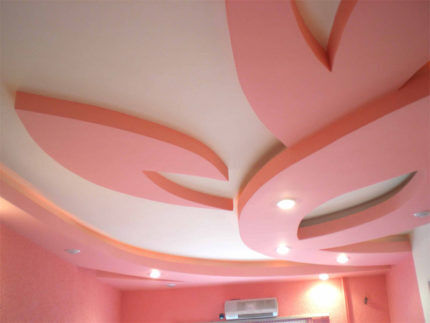
Such ceilings make the height of the room smaller and, due to this, have good thermal insulation, which is especially important for owners of apartments on the upper floors.
Some types of materials for suspended ceilings can provide sound insulation in a room, which will be very helpful if noisy neighbors live on the floor above.
Main types of suspended ceilings
The simplest and most common type of suspended ceiling is solid plasterboard ceiling. All other types of ceilings are called modular, as they consist of special slabs and slats.
Suspended modular ceilings have a wide variety of designs and can have one or several levels. Their surface can be glossy, matte or mirror, and the pattern and color can be any.
Let's look at the main types of suspended ceilings in more detail.
Option #1 - panel structures
Such ceilings consist of square or rectangular panels. Panel ceilings are laconic and straightforward, which is why they are most often used to decorate various non-residential premises.
The system itself assumes access to hidden communications. It's also easy to get into install lighting equipment.
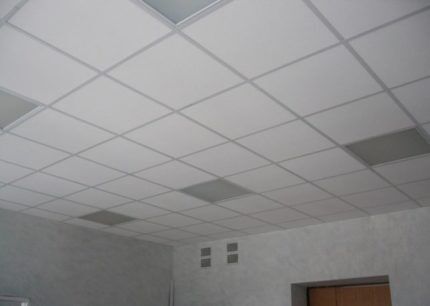
The Armstrong tiled ceiling has a number of advantages, including:
- Possibility of installation on large areas of more than 1000 square meters.
- Creating a perfectly flat surface.
- Free access to ventilation.
- Fast and easy installation.
You can find ceiling tiles made of MDF and fiberboard, metal, mineral and fiberglass.
Also, the plates themselves can be endowed with additional properties:
- acoustic;
- ventilation;
- thermal insulation;
- moisture resistant.
If desired, you can apply any image or decorative elements to the panels.
The most expensive option is considered to be panels made of natural wood, the beauty of which cannot be compared with any, even the highest quality imitation.
Option #2 - cassette ceilings
Such ceilings are easy to maintain and have a rather attractive appearance. The finish can be very different: mirror, matte, with polymer coatings and metallized.
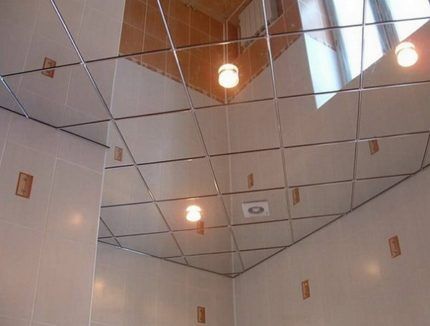
The hidden type design allows the frame to be completely covered with cassettes. It is easy to assemble such a ceiling, and, if necessary, it is also easy to partially disassemble it. For example, to get to internal communications. Such systems are not afraid of water and fire.
Perhaps its only drawback is its rather high cost.
Option #3 - slatted ceilings
The slatted ceiling system uses long slats. The structure is attached to the ceilings with special clamps (knitting needles). Such ceilings are usually made of aluminum, steel or PVC.
Aluminum ceiling slats, in turn, have two common styles:
- Italian style. The slats are high with rounded edges. Both open and hidden types of fastening can be used for them.
- German style. Rectangular slats, which can be with or without perforation.
PVC slats are narrow - from 10 to 12.5 cm and wide from 15 to 50 cm. The former are usually called lining, and the latter - panels.
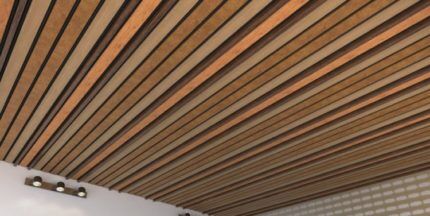
PVC slatted ceiling will not hurt your pocket and is best suited for a bathroom or kitchen.
Option #4 - plasterboard structures
Unlike previous types of ceilings, a plasterboard structure after installation requires decorative finishing with putty and subsequent painting.
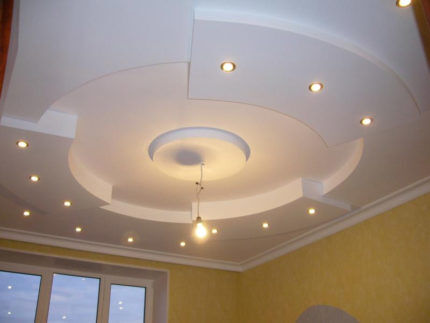
In addition to the aesthetic advantages of a plasterboard ceiling, the characteristics of the selected plasterboard also play an important role: regular, moisture-resistant or fire-resistant. Its choice, in turn, depends on the purpose of the room.
Suspended plasterboard ceilings come in various forms, for example:
- Framework. They consist of a box with one or several steps. It is possible to place hidden lighting around the perimeter of the box.
- Diagonal. They have a flat base with protruding lower levels above one side of the room.
- Abstract. They consist of several irregularly shaped elements arranged in a spiral.
- Zonal. They allow you to highlight a part of the room by defining the boundaries of a zone, for example a work zone.
- Curly. They have a flat base, against which, as a rule, in the center of the ceiling, a figured geometric structure stands out.
The advantage of this material is also its low cost.
Calculation of required materials
After choosing the type of suspended ceiling, you should decide on the required amount of materials. To do this, you need to measure the area of the ceiling and preferably develop a sketch, which will greatly facilitate the upcoming work.
The materials for the frame for almost all types of ceilings will be similar, so we will give an example of calculating the necessary materials for an Armstrong-type panel ceiling.
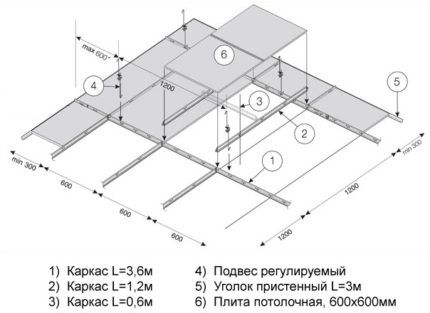
In order to understand the material consumption standards for an Armstrong-type suspended ceiling frame, imagine that we have a square room with an area of 25 m2.
To install a panel ceiling you will need the following materials:
- main profile 3.6 m long;
- cross profile 1.2 m long;
- cross profile 0.6 m long;
- pendants;
- wall corner 3.0 m long;
- dowel-screws;
- anchor dowels;
- panel slabs 600*600 mm.
Installation of the main profile is carried out in increments of 1200 mm. To find out the number of rows of the main guide, divide the width of the room 5 m by 1.2 (step) and get 4.17 rows. The next step is to find out how many linear meters of this profile are required. To do this, multiply the length of the room 5 m by the number of rows 4.17 and get 20.9 m.p.
Installation of a transverse profile 1.2 m long is carried out in increments of 600 mm. To find out the number of rows of the transverse profile, divide the length of the room 5 m by 0.6 (step) and get 8.33 rows. Next, we will find out the required amount of profile in linear meters. To do this, multiply the width of the room 5 m by 8.33 (rows) and get 41.7 m.p.
The installation step of a transverse profile 0.6 m long is 1200 mm. The number of rows of the transverse profile is calculated by dividing the length of a room of 5 m by 1.2 (step). We get 4.17 rows. We multiply the resulting value by 5 m - the width of the room and get 20.9 m.p. – this quantity is needed for an area of 25 m2.
The hangers are installed on the main guides with a pitch of 1200 mm. To find out the number of hangers for 1 row of main guides, divide the length of the room of 5 m by the hanger pitch of 1.2 and get 4.17 hangers for 1 row.
Previously we found out that we have 4.17 rows of main guides. Accordingly, for a room 5 x 5 m you will need 4.17 rows multiplied by 4.17 and we get 17.39 pieces of hangers.
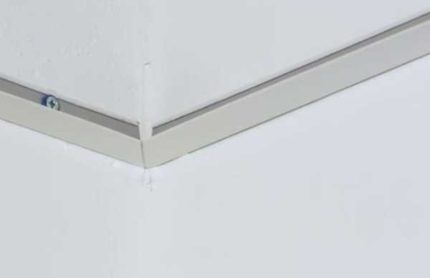
Therefore, 20 m of wall corner will be required.
To calculate the number of panel slabs, it is enough to know the area of one slab (0.6 x 0.6 = 0.36) and then divide the ceiling area of 25 by the area of one slab of 0.36. In total, we get 70 pieces.
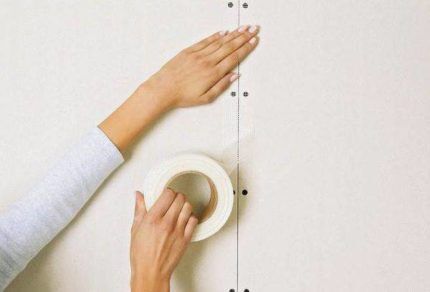
Fastening elements should be purchased on the basis that one dowel is needed per 0.5 m of profile.
To install a plasterboard ceiling you will need the following materials:
- guide profile 27 x 28 cm;
- ceiling profile 60 x 27 cm;
- straight U-shaped hangers;
- dowel-nails;
- self-tapping screws;
- 9.5 mm thick plasterboard sheets.
To finish plasterboard ceilings, additional materials will be required, such as primer, putty and water-based paint.
Stage-by-stage installation work
Regardless of the choice of type of suspended ceiling, the main thing in their installation is that they are all attached to the frame, and the frame to the sub-ceiling. Only the design of the frame itself will differ.
Before installing any type of suspended ceiling, a number of preparatory measures should be completed:
- Clearing the room of furniture.
- Preparing the ceiling. For example, eliminating cracks and cracks to avoid heat loss in the future, ceiling insulation and him sound insulation.
- Laying communications. For example, installation of ventilation systems and wiring for lighting fixtures.
After calculating the amount of necessary materials and carrying out preparatory work, you can begin installing the suspended ceiling.
Method of installing panel ceilings
Let us consider the installation work step by step using the example of installing Armstrong-type suspended panel ceilings.
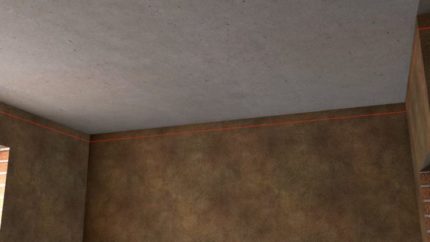
After this, a wall corner is attached to the walls along the perimeter of the room using dowels in increments of no more than 0.5 m.
Next, the main load-bearing profiles, 3.7 m long, are installed in increments of 1.2 m parallel to the wall. After this, hangers are attached to the ceiling and the supporting rail in increments of 1.2 m.
Transverse profiles 1.2 m long are installed perpendicular to the main slats in increments of 0.6 m. Transverse profiles 0.6 m long are installed parallel to the main slats at a distance of 1.2 m from each other.
After assembling the frame, begin installing the ceiling tiles.
The installation of suspended cassette and slatted ceilings is similar to the installation of Armstrong-type ceilings, the only difference is the use of cassettes or slats instead of slabs.
Installation of plasterboard ceilings
The first step is to apply markings, and, most importantly, a straight line along which the guide profile will be attached. A laser level is best suited for this. It is also necessary to mark the mounting points for the suspensions.
The guide profile 27 x 28 cm should be attached with dowels around the perimeter of the room using a screwdriver or hammer drill.
Next, direct suspensions are attached to the ceiling using metal anchors according to the applied markings in increments of 60 cm. After this, the ceiling profile 60 x 27 cm must be cut to length and inserted into the guides in increments of 40 cm.
The hangers need to be lowered and screwed to the profile with self-tapping screws. The excess part of the suspension must be folded inward.
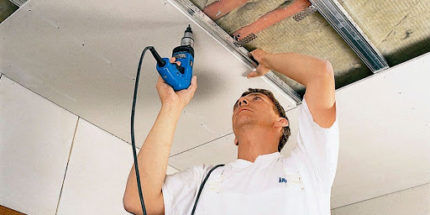
After installing the drywall sheets, you can begin finishing work. To do this, you need to clean the ceiling from dust.
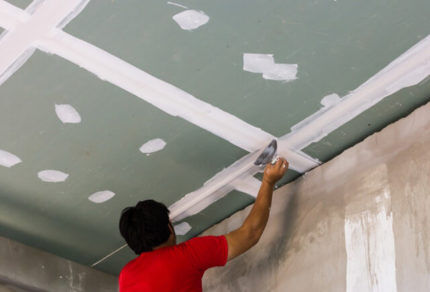
It is necessary to wait until it dries completely and cover the entire surface with primer. After this, you can proceed to finishing the entire surface with putty.
Before painting with water-based paint, it is necessary to apply another coat of primer.
Conclusions and useful video on the topic
Installation of Armstrong suspended panel ceiling:

Installation of a plasterboard ceiling with a niche for lighting:

The choice of suspended ceilings is very large and depends only on your preferences and financial capabilities. A correctly selected and installed ceiling can not only hide possible shortcomings, but also change the perception of space in the room.
You can install suspended ceilings yourself. The main thing is not to rush, but to do the preparatory work correctly and adhere to the technology.
Have you ever had to install suspended ceilings yourself? Please tell our readers which species you preferred and what your choice was based on. Were there any difficulties with installation? Leave your comments, add photos, ask questions and share your experience in the contact block under the article.



